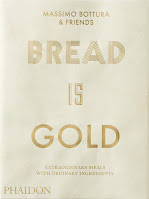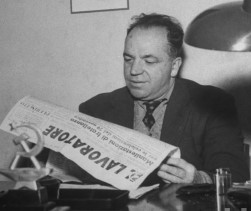Massimo Bottura - chef and food activist
Leading restaurateur who set up project to feed hungry
The chef and restaurateur Massimo Bottura, whose Osteria Francescana in his hometown of Modena has twice been named as the world’s best restaurant, was born on this day in 1962. Bottura is also the founder, in partnership with his American-born wife, the former actress and artist Lara Gilmore, of Food for Soul, a non-profit organisation that sets out to combat waste and feed the hungry through a network of refectories in major cities around the world. The Food for Soul project was launched in 2015 with a refettorio in Greco, a poor district of northern Milan, and has expanded to the extent that it now numbers seven similar dining rooms for the hungry and homeless, in London, Paris and Rio de Janeiro as well as at three other locations in Italy. As a young man, Bottura’s passions were food and football. He drew inspiration from the cooking of his mother and grandmothers in his dream of being a chef but envisioned a career as a footballer first, believing he had the talent to play professionally. His father, a successful businessman, insisted he followed a different path, and Bottura enrolled instead to study law at university. Read more…
______________________________________
Pierina Legnani - ballerina
Italian dancer who conquered St Petersburg
The ballerina Pierina Legnani, considered by many ballet historians to be one of the greatest dancers in history, was born on this day in 1863 in Milan. Legnani's legacy was the 32-turn fouetté en tournant in which the dancer essentially spins on the point of one foot for 32 revolutions while maintaining perfect balance. No ballerina had completed 32 turns before Legnani, who is said to have tried it out at the Alhambra Theatre in London before introducing the move to the wider world in 1893 on her debut at the Imperial Ballet in St Petersburg in Russia, where she was performing in the title role of Cinderella. It came in the final act on the night of the premiere and her perfection of technique and execution caused a sensation, with many critics hailing her as the supreme ballerina of her generation. Her feat set a new standard for future ballerinas as a yardstick of strength and technique. A sequence of 32 fouetté turns was later choreographed into the Black Swan solo in Act Three of Swan Lake, of which it continues to be a feature. Jealous rivals criticised Legnani for what they saw as showing off, taking an audacious gamble that could have backfired horribly. Read more…
______________________________________
Angelo Cerica - Carabinieri general
First job was to arrest Mussolini
General Angelo Cerica, the police commander tasked with arresting the Fascist dictator Benito Mussolini after he was deposed as party leader in 1943, was born on this day in 1885 in Alatri, in the Ciociaria region of Lazio, about 90km (56 miles) south of Rome. Mussolini was arrested on July 25 as he left his regular meeting with the King, Vittorio Emanuele III, the day after the Fascist Grand Council had voted to remove him from power. The monarch had informed him that General Pietro Badoglio, former chief of staff of the Italian army, would be replacing him as prime minister. Cerica had been appointed Commander-in-Chief of the Carabinieri, Italy’s paramilitary second police force, only two days previously, succeeding General Azolino Hazon, who had been killed in a bombing raid. He was hand-picked for the job by General Vittorio Ambrosio, who was party to a secret plot among Carabinieri officers to depose Mussolini irrespective of the Grand Council vote. They wanted a commander who would not oppose the anti-Mussolini faction and would carry out the arrest. Cerica, in fact, shared their view of il Duce, blaming him for leading Italy into a ruinous alliance with Germany. Read more…
______________________________________
Monica Bellucci - actress and model
Movie actress who became face of Dolce & Gabbana
The actress and model Monica Bellucci, who has appeared in more than 60 films in a career that began in 1990, was born on this day in 1964 in Città di Castello in Umbria. Bellucci, who is associated with Dolce & Gabbana and Dior perfumes, began modelling to help fund her studies at the University of Perugia, where she was enrolled at the Faculty of Law with ambitions of a career in the legal profession. But she was quickly brought to the attention of the major model agencies in Milan and soon realised she had the potential to follow a much different career. Bellucci, whose father Pasquale worked for a transport company, soon began to attract big-name clients in Paris and New York as well as Italy, but decided not long into her modelling career that she would take acting lessons. She claimed to have been inspired by watching the Italian female movie icons Claudia Cardinale and Sophia Loren and gained her first part in a TV miniseries directed by the veteran director Dino Risi in 1990. The following year she made her big screen debut with a leading role in the film La raffa, directed by Francesco Laudadio. Read more…
______________________________________
Girolamo Mercuriale – physician
Doctor went from hero to villain and back again
Girolamo Mercuriale, who is believed to have written the first book about sports medicine and one of the first books about the benefits of physical exercise, was born on this day in 1530 in Forlì. He published his most famous book, De Arte Gymnastica, in 1569 in Venice, having studied Greek and Roman medical literature and learnt about the attitude of athletes in ancient times to diet, exercise and hygiene. Girolamo was the son of a doctor, Giovanni Mercuriale, and he was sent to Bologna, Padua and Venice to study medicine. After receiving his doctorate in philosophy and medicine in 1555 in Venice he went to Rome on a political mission, where he had access to many of the important libraries housing classical manuscripts. His book is believed to be the first to explain the principles of physical therapy, now known as physiotherapy and the first to suggest that exercise can be helpful, or harmful, depending on its use, duration and intensity. He became famous and was offered the chair of practical medicine at Padua in 1569, where he studied the works of Hippocrates, which gave him the material to write the first scientific tracts on skin disease, and women’s and children’s diseases. Read more…
_______________________________________
Book of the Day: Bread Is Gold: Extraordinary Meals With Ordinary Ingredients, by Massimo Bottura
Massimo Bottura, the world's best chef, prepares extraordinary meals from ordinary and sometimes 'wasted' ingredients inspiring home chefs to eat well while living well. In Bottura’s words: “These dishes could change the way we feed the world, because they can be cooked by anyone, anywhere, on any budget. To feed the planet, first you have to fight the waste.” Bread is Gold is the first book to take a holistic look at the subject of food waste, presenting recipes for three-course meals from 45 of the world's top chefs, including Daniel Humm, Mario Batali, René Redzepi, Alain Ducasse, Joan Roca, Enrique Olvera, Ferran & Albert Adrià and Virgilio Martínez. These recipes, which number more than 150, turn everyday ingredients into inspiring dishes that are delicious, economical, and easy to make.
The chef-patron of Osteria Francescana, a three-Michelin-star restaurant that he opened in 1995 in Modena, Italy, which was ranked number one in the World's 50 Best in 2016, Massimo Bottura was interested in cooking from a young age. He is also the author of Never Trust a Skinny Italian Chef.

.jpg)

.jpg)


.jpg)

.jpg)







%20(1).jpg)



.jpg)






.jpg)










.jpg)
.jpg)
